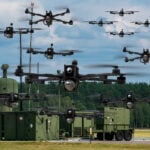Atlantic Council – How modern militaries are leveraging AI

Atlantic Council’s Scowcroft Center for Strategy and Security just published a report on AI in modern militaries titled “Battlefield Applications for Human-Machine Teaming: Demonstrating Value, Experimenting with New Capabilities, and Accelerating Adoption,” authored by Tate Nurkin and Julia Siegel.
The report analyzes the increasing integration of artificial intelligence (AI) into military operations, emphasizing the significance of human-machine teaming (HMT). The authors argue that modern militaries must adopt HMT or risk losing their competitive edge to rivals who effectively utilize AI and autonomy.
Key Insights:
- The Importance of Human-Machine Teaming (HMT): Machines are becoming pervasive in the modern battlespace. The report highlights the need for militaries to embrace HMT to maintain their competitive edge. The term HMT encompasses both the teaming of human operators with semi-autonomous machines and interactions between humans and AI agents without a physical form.
- Applications of HMT: The authors discuss the potential of HMT to transform warfare by enhancing situational awareness, improving decision-making, extending the range and lethality of human operators, and achieving advantages across multi-domain operations. They also emphasize the need for the Department of Defense (DOD) to expand its definitions of HMT to include a broader range of human interactions with autonomous systems and AI agents.
- Challenges and Recommendations: The report identifies challenges in adopting HMT, such as bureaucratic hurdles, risk-averse cultures, and the need for trust between human operators and AI systems. Recommendations include prioritizing human-centric teaming, transitioning from conceptual discussions to practical applications, and emphasizing the importance of real-world experimentation.
- Applications and Use Cases: The authors provide examples of HMT in action, such as the “loyal wingman” concept where human pilots control autonomous aerial systems. They also discuss the potential of HMT in areas like intelligence analysis, target identification, and decision support.
- Future Implications: The report suggests that HMT can offer multiple layers of advantages to the US and its allies, from operational benefits to cost savings. However, to realize these benefits, the DOD must address challenges, build trust, establish ethical and safety norms, and promote clear messaging about the value of HMT.
The report underscores the transformative potential of AI and HMT in modern warfare. It offers a comprehensive overview of the current state of HMT adoption, its applications, challenges, and the path forward for militaries aiming to harness the power of AI effectively.
For 30+ years, I've been committed to protecting people, businesses, and the environment from the physical harm caused by cyber-kinetic threats, blending cybersecurity strategies and resilience and safety measures. Lately, my worries have grown due to the rapid, complex advancements in Artificial Intelligence (AI). Having observed AI's progression for two decades and penned a book on its future, I see it as a unique and escalating threat, especially when applied to military systems, disinformation, or integrated into critical infrastructure like 5G networks or smart grids. More about me, and about Defence.AI.











































